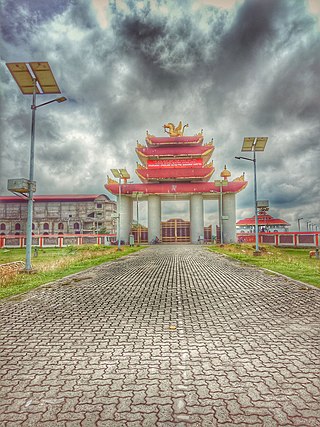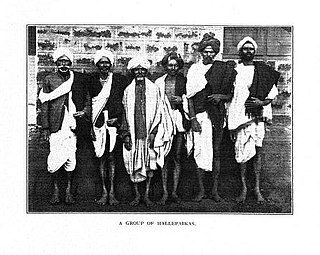This article needs additional citations for verification .(April 2016) |
The Gandharv (sometimes pronounced Gandharb) are a Hindu community found in North India. [1]
This article needs additional citations for verification .(April 2016) |
The Gandharv (sometimes pronounced Gandharb) are a Hindu community found in North India. [1]
The Gandharv are an ancient community, frequently mentioned in ancient Sanskrit texts as a group associated with singing and dancing to entertain the gods. They are divided into seven exogamous clans, known as gotras. These seven clans are the Arakh, Sital, Ramsi, Shahimal, Hiwan, Panchbhaiya, and Dhomana. The Gandharv are found mainly in the Hindu holy cities of Allahabad and Varanasi. They speak both standard Hindi and the Bhojpuri dialect. [1] Traditionally, the Gandharv were a community of singers and musicians, who were often employed by nautch girls. Half of the fees were given to the Gandharv. They have a seen a decline in their traditional occupation, and many are now landless agricultural labourers.
Rajput, also called Thakur, is a large multi-component cluster of castes, kin bodies, and local groups, sharing social status and ideology of genealogical descent originating from the Indian subcontinent. The term Rajput covers various patrilineal clans historically associated with warriorhood: several clans claim Rajput status, although not all claims are universally accepted. According to modern scholars, almost all Rajput clans originated from peasant or pastoral communities.

The Ahom or Tai-Ahom is an ethnic group from the Indian states of Assam and Arunachal Pradesh. The members of this group are admixed descendants of the Tai people who reached the Brahmaputra valley of Assam in 1228 and the local indigenous people who joined them over the course of history. Sukaphaa, the leader of the Tai group and his 9,000 followers established the Ahom kingdom, which controlled much of the Brahmaputra Valley in modern Assam until 1826.
In Hindu culture, the term gotra is considered to be equivalent to lineage. It broadly refers to people who are descendants in an unbroken male line from a common male ancestor or patriline. Generally, the gotra forms an exogamous unit, with marriage within the same gotra being regarded as incest and prohibited by custom. The name of the gotra can be used as a surname, but it is different from a surname and is strictly maintained because of its importance in marriages among Hindus, especially among castes. Pāṇini defines gotra as apatyam pautraprabhrti gotram, which means "the word gotra denotes the descendance, apatya, of a couple consisting of a pautra, a son and a bharti, a mother, i.e. a daughter-in-law."

The Yadava were an ancient Indian people who believed to be descended from Yadu, a legendary king of Chandravamsha lineage.

Puntambekar is an Indian surname. It is found amongst Marathi speaking Deshastha Brahmin and Karhade Brahmin communities of Maharashtra. Marathi surnames are created by adding the suffix -kar to the family's town of origin; therefore, people originating from the town of Puntamba take the name Puntambekar.
The Gurjar are an Indo-Aryan agricultural ethnic community, residing mainly in India, Pakistan and Afghanistan, divided internally into various clan groups. They were traditionally involved in agriculture, pastoral and nomadic activities and formed a large heterogeneous group. The historical role of Gurjars has been quite diverse in society: at one end they have been founders of several kingdoms and dynasties and, at the other end, some are still nomads with no land of their own.

Namadhari Naik, also known as Hale paika, Namadhari Naik, Namadhari Gowda, is a Hindu warrior community predominantly found in Uttara Kannada of Karnataka State in India, and forms the numerical majority in the region. Traditionally, members of the Namadhari Naik community have been engaged in agriculture, military service, and priesthood, though toddy tapping once formed an important source of income. The surnames Nayak (ನಾಯಕ) and Naik (ನಾಯ್ಕ), along with Gowda, are commonly used among community members, signifying their status and lineage.
The Tirgar caste found in the states of Gujarat and Rajasthan in India.
The Salvi are found in the states of Gujarat and Rajasthan in India.
The Kandera, Kadera, Golandāz, Bāndar, Hawāidar is a Hindu community found mainly in the northern and central regions of India. They belong to the Kshatriya varna. In earlier times, they were archers and arrow-makers. Later, they also became involved in roles such as cannon operators, firework crafters, and the production of gunpowder and iron missiles. The term "Kandera" is derived from the Sanskrit word "Kandir", which means "an archer".
Mansoori (Mansuri) is the community of an Indian Muslim, and this community belongs to Pathans and Rajputs. They are regionally known as Mansoori, Naddaf and Pinjara. They are found in the states of Gujarat, Madhya Pradesh, Rajasthan, Uttar Pradesh, Bihar, and North India.
The Patharkat are a Hindu caste found in North India. They are also known as Sangtarash.

The Nat are a Hindu caste found in northern India.
The Gihar are a Hindu caste found in various states of India. They belong to the Gipsy clan. They are considered to be among the nomadic or partially-settled communities.
The Bhambi Sindhi Mochi are a Hindu caste found in the state of Gujarat in India. They are also known as Sindhi Mochi. The Bhambi Sindhi Mochi are sub-group within the Bhambi community.
The Sikligar is a community found in the Indian states of Gujarat, Haryana, Rajasthan, and Punjab. By tradition, the Sikligar people specialized in the craft of making and polishing weapons. They are typically Hindu in Gujarat, Telangana, and Andhra Pradesh; Sikh in Punjab; and either Hindu and Sikh in Haryana.
The Chhaparband are a Hindu caste found in the states of Karnataka and Maharashtra in India. They are also known as Chhaparbasi, Chhaparwale and Rajput Chhaparband.
The Bansphor are a Hindu caste found in the state of Uttar Pradesh, India.
The Hurkiya are a caste found in the states of Uttar Pradesh and Uttarakhand in India. They have been granted Scheduled Caste status in both these states. In fact, there are two distinct communities that go by the name Hurkiya, those of Uttarakhand, who are Hindu by religion, and those found in western Uttar Pradesh, who are Muslim. Both Hurkiya are of common origin, being a sub-group within the Dom ethnic group, and are one of the many gypsy like grouping found in North India.

Sutradhar, also known as Sutar or Suthar is a Hindu caste within the Vishwakarma community of Indian subcontinent. Their traditional occupation is carpentry. The great majority of Hindu sutradhars belong to the Vaishnava sect. Vishwakarma is regarded as their patron deity.